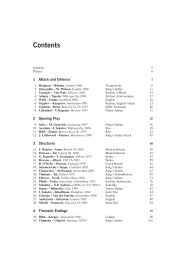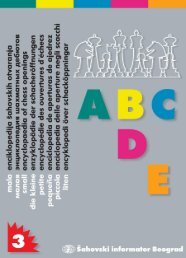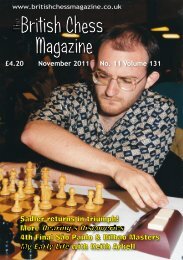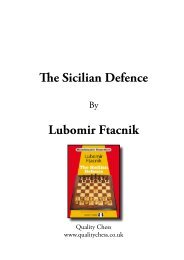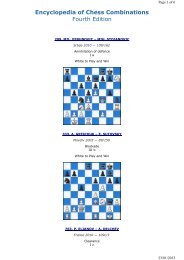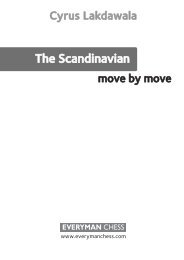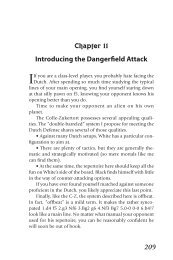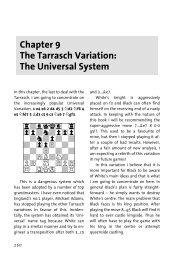The Current Status of Queen's Pawn Game Responses to - Zuka
The Current Status of Queen's Pawn Game Responses to - Zuka
The Current Status of Queen's Pawn Game Responses to - Zuka
Create successful ePaper yourself
Turn your PDF publications into a flip-book with our unique Google optimized e-Paper software.
Background: <strong>The</strong> <strong>Current</strong> <strong>Status</strong> <strong>of</strong><br />
Queen’s <strong>Pawn</strong> <strong>Game</strong> <strong>Responses</strong> <strong>to</strong><br />
…g6-systems<br />
B<br />
efore jumping in<strong>to</strong> a detailed look at how <strong>Zuka</strong> can be<br />
used against various ...g6 systems, a quick discussion <strong>of</strong><br />
the current state <strong>of</strong> theory seems appropriate.<br />
When discussing deviations from “Queen’s <strong>Pawn</strong> <strong>Game</strong>”<br />
openings, loosely defined as anything where White opens<br />
1.d4 and delays or omits c4, one can identify two categories<br />
that match two very different kinds <strong>of</strong> Black reper<strong>to</strong>ires.<br />
<strong>The</strong> first category comprises the various pet defenses,<br />
each designed <strong>to</strong> defuse an individual opening. <strong>The</strong> second<br />
category comprises recognized opening systems that naturally<br />
cut across White’s plans; examples include the Benoni, Dutch,<br />
and King’s Indian defenses. While challenging lines exist in<br />
both categories, the members <strong>of</strong> the second group are particularly<br />
problematic because they tend <strong>to</strong> result in structures the<br />
second player is well versed in playing. A <strong>to</strong>urnament player<br />
might have <strong>to</strong> use each <strong>of</strong> his pet defenses once a year, but a<br />
Benoni specialist is going <strong>to</strong> bash out 1.d4 Nf6 2.Nf3 c5 many<br />
times each month.<br />
Furthermore, these “real” defenses are much more likely <strong>to</strong><br />
provide Black substantial winning chances. Compare this <strong>to</strong><br />
many pet defenses that make White work harder <strong>to</strong> achieve a<br />
significant advantage in the opening, but which can be quite<br />
hard for Black <strong>to</strong> win with even against mediocre play should<br />
White be happy with a draw. Examples include meeting the<br />
Colle with 1.d4 Nf6 2.Nf3 d5 3.e3 Bf5 or the accelerated London<br />
with 1.d4 Nf6 2.Bf4 d6.<br />
But these two categories differ in another important regard.<br />
Pet lines are rarely tested at high levels, and their theory<br />
15
<strong>Zuka</strong>: <strong>The</strong> Zuke Companion<br />
changes slowly. Once White finds the proper refutation for<br />
such a line, it can be a long time before it gets resurrected.<br />
At one point many <strong>of</strong> these variations could have been considered<br />
silver bullets, but their tips have since degraded <strong>to</strong><br />
bronze or clay. Not so with the Modern, Pirc, Benoni, Grünfeld,<br />
Dutch, and Indian systems. Many <strong>of</strong> these are played at<br />
high levels regularly, and the opportunity for developments,<br />
even in their sidelines—the variations Queen’s <strong>Pawn</strong> <strong>Game</strong><br />
players may adopt—is much greater. A recommendation for<br />
White that looked good in 2000 may have already had its<br />
c<strong>of</strong>fin made by 2010.<br />
Of these various defensive systems, those employing an<br />
early ...g6 are particularly difficult for Colle System players <strong>to</strong><br />
meet. <strong>The</strong> knee-jerk explanation for this is that White’s powerful<br />
Bishop on d3 bites on g6-granite. This reasoning contains<br />
some truth, especially for the C-K version which relies heavily<br />
on that Bishop. Yet it glosses over a more fundamental<br />
point. As I described in Zuke ’Em, the Colle-Zuker<strong>to</strong>rt aims <strong>to</strong><br />
render Black’s light-squared Bishop as worthless as possible.<br />
If Black fianchet<strong>to</strong>es his dark-squared Bishop, White has no<br />
real hope <strong>of</strong> containing Black’s light-squared Bishop with a<br />
Colle structure because there is no compelling reason for the<br />
second player <strong>to</strong> issue ...e6.<br />
This short circuits White’s whole setup. Not only will Black<br />
get <strong>to</strong> make some use <strong>of</strong> his light-squared Bishop, but he does<br />
not need <strong>to</strong> take any drastic early action <strong>to</strong> do so. No wonder<br />
the Colle stands <strong>to</strong> do poorly against the ...g6 systems: Black<br />
has sabotaged from the start the whole basis <strong>of</strong> White’s opening!<br />
(Incidentally, the <strong>Zuka</strong> system I will be recommending<br />
renews this idea <strong>of</strong> suppressing Black’s play with this Bishop<br />
by eventually covering g4 and f5 with pawns on e4 and either<br />
f3 or h3.)<br />
Because theory can change relatively rapidly even in the<br />
sidelines <strong>of</strong> these defensive systems, many different suggestions<br />
for White have been given over the years. Smith and Hall<br />
16
<strong>The</strong> <strong>Current</strong> <strong>Status</strong> <strong>of</strong> Queen’s <strong>Pawn</strong> <strong>Game</strong> …g6-systems<br />
actually suggested something close <strong>to</strong> the <strong>Zuka</strong> system against<br />
one particular ...g6 line, but they looked for massive Q‐side<br />
expansion with a4 and b4, allowing Black <strong>to</strong> play ...e4. Soltis<br />
suggested White simply use a Torre against these openings in<br />
his 1992 reper<strong>to</strong>ire pamphlet.<br />
A new era began when GM Summerscale suggested the<br />
Barry and 150 Attack in the original edition <strong>of</strong> A Killer Chess<br />
Opening Reper<strong>to</strong>ire.<br />
<strong>The</strong> Barry Attack<br />
<strong>The</strong> Barry Attack (1.d4 Nf6 2.Nf3 g6 3.Nc3 d5 4.Bf4 Bg7<br />
5.e3 0-0 6.Be2) provoked much debate as it was used with<br />
some success by several strong players.<br />
!@@@@@@@@#<br />
$‰NıQzRapplex%<br />
$P∏PzP∏B∏%<br />
$zxzxzN∏x%<br />
$xzx∏xzxz%<br />
$zxzpzbzx%<br />
$xznzpñxz%<br />
$πpπx∫pπp%<br />
$rzxœkzx®%<br />
^&&&&&&&&*<br />
<strong>The</strong> Barry instantly became the preferred method for up<strong>to</strong>-date<br />
Colle players <strong>to</strong> engage the ...g6 defensive complexes.<br />
Unfortunately, as is <strong>of</strong>ten the case in chess, success for White<br />
at high levels accelerated the evolution <strong>of</strong> the line. Black finally<br />
found a reliable response involving an annoying retreat:<br />
6...c5 7.Ne5 cxd4 8.exd4 Nfd7!<br />
17
<strong>Zuka</strong>: <strong>The</strong> Zuke Companion<br />
!@@@@@@@@#<br />
$‰NıQzRapplex%<br />
$P∏x˜P∏B∏%<br />
$zxzxzx∏x%<br />
$xzx∏nzxz%<br />
$zxzpzbzx%<br />
$xznzxzxz%<br />
$πpπx∫pπp%<br />
$rzxœkzx®%<br />
^&&&&&&&&*<br />
White doesn’t have anything better than 9.Nf3, so he had<br />
<strong>to</strong> find a way <strong>to</strong> make progress without Ne5.<br />
This ...Nfd7 tactic had been known even before Summerscale’s<br />
book. Long-time Barry proponent Mark Hebden beat<br />
widely renowned opening theorist GM John Nunn in 1998<br />
by castling long after playing Qd2, Ne5, and Be3. However,<br />
Hebden evidently didn’t trust the specific continuation in<br />
that game and ran in<strong>to</strong> trouble with this line in 2005-6 as<br />
he started looking for something better. He even tried Ng1<br />
against fellow GM Jonathan Rowson. Nothing came <strong>of</strong> this<br />
experimentation and he agreed <strong>to</strong> a couple <strong>of</strong> draws from the<br />
position in 2006.<br />
In my view 7...cxd4 8.exd4 Nfd7 is the biggest issue for<br />
Barry Attack players. IMs Richard Palliser and Yelena Dembo<br />
(writing from opposite sides <strong>of</strong> the chess board) have each<br />
put more weight on the 7...Nc6 variation.<br />
18
<strong>The</strong> <strong>Current</strong> <strong>Status</strong> <strong>of</strong> Queen’s <strong>Pawn</strong> <strong>Game</strong> …g6-systems<br />
!@@@@@@@@#<br />
$‰xıQzRapplex%<br />
$P∏xzP∏B∏%<br />
$zx˜xzN∏x%<br />
$xzP∏nzxz%<br />
$zxzpzbzx%<br />
$xznzpzxz%<br />
$πpπx∫pπp%<br />
$rzxœkzx®%<br />
^&&&&&&&&*<br />
Position after 7...Nc6<br />
It’s true that White has gotten the worse <strong>of</strong> it from this<br />
position in recent years if one looks at all games, but closer<br />
examination shows that this is largely due <strong>to</strong> White stubbornly<br />
trying <strong>to</strong> attack come hell or high water with h4 or<br />
playing Nxc6 <strong>to</strong>o early. <strong>The</strong> traditional move, 8.0‐0 continues<br />
<strong>to</strong> work fine for White, who must now play positionally on<br />
the Q-side.<br />
<strong>The</strong> variation that Dembo gives as the refutation <strong>to</strong> White’s<br />
setup is 8.0-0 cxd4 9.exd4 Qb6 10.Nxc6 Qxc6.<br />
!@@@@@@@@#<br />
$‰xıxzRapplex%<br />
$P∏xzP∏B∏%<br />
$zxŒxzN∏x%<br />
$xzx∏xzxz%<br />
$zxzpzbzx%<br />
$xznzxzxz%<br />
$πpπx∫pπp%<br />
$rzxœx®kz%<br />
^&&&&&&&&*<br />
Does this pose<br />
a problem for White?<br />
19
<strong>Zuka</strong>: <strong>The</strong> Zuke Companion<br />
Palliser agrees with Dembo’s assessment that White has<br />
nothing here, but I think they have under-estimated 11.Re1<br />
a6 12.Bf3, which Dembo gives a “?!” <strong>The</strong> Greek IM criticizes<br />
this move because it does not s<strong>to</strong>p Black’s minority attack,<br />
but in the suggested continuation she gives, 12...Be6 13.a4<br />
b5 14.axb5 axb5, I don’t see what Black has accomplished<br />
after 15.Na2.<br />
!@@@@@@@@#<br />
$‰xzxzRapplex%<br />
$xzxzP∏B∏%<br />
$zxŒxıN∏x%<br />
$x∏x∏xzxz%<br />
$zxzpzbzx%<br />
$xzxzx∫xz%<br />
$ñpπxzpπp%<br />
$rzxœrzkz%<br />
^&&&&&&&&*<br />
<strong>The</strong> b4-square belongs <strong>to</strong> White<br />
Following c3, Nb4, and probably Rc1, Black cannot make<br />
anything <strong>of</strong> the a-file. Note that he has problems finding a<br />
spot for his light-squared Bishop. He would like <strong>to</strong> move<br />
the Bishop <strong>to</strong> allow ...e6, shoring up the twice-hit d5-pawn.<br />
Rerouting it <strong>to</strong> e8 is complicated by the weakness on e7, and<br />
moving it <strong>to</strong> f5 invites a powerful K-side pawn s<strong>to</strong>rm. Retreating<br />
all the way <strong>to</strong> c8 leaves Black even less well-prepared <strong>to</strong><br />
meet a K-side assault.<br />
While I don’t see 7...Nc6 as particularly problematic, it<br />
does prevent White from playing for an immediate K‐side assault.<br />
It is a stylistic obstacle rather than a theoretic one.<br />
<strong>The</strong> Tarzan Attack<br />
<strong>The</strong> Barry Attack lost its greatest advocate when Hebden<br />
switched openings after his dispiriting encounters <strong>of</strong> 2005-<br />
2006 against 8...Nfd7. He began tilling the fields <strong>of</strong> 1.d4 Nf6<br />
20
<strong>The</strong> <strong>Current</strong> <strong>Status</strong> <strong>of</strong> Queen’s <strong>Pawn</strong> <strong>Game</strong> …g6-systems<br />
2.Nf3 g6 3.Nc3 d5 4.Bf4 Bg7 5.Qd2, which Israeli GM Arthur<br />
Kogan had been cultivating for some time.<br />
!@@@@@@@@#<br />
$‰NıQapplexzR%<br />
$P∏PzP∏B∏%<br />
$zxzxzN∏x%<br />
$xzx∏xzxz%<br />
$zxzpzbzx%<br />
$xznzxñxz%<br />
$πpπqπpπp%<br />
$rzxzk∫x®%<br />
^&&&&&&&&*<br />
White’s play, aiming at Bh6 with a K-side assault, may not<br />
appear particularly nuanced, but it has proven quite hard <strong>to</strong><br />
contain. <strong>The</strong> variation has received a fair amount <strong>of</strong> attention<br />
recently, and its theory is still evolving. Several reper<strong>to</strong>ire<br />
books have suggested Black play for a relatively early ...c5 after<br />
5...Ne4 6.Nxe4 dxe4 7.Ne5 Nd7 8.Nxd7 Qxd7 9.e3 0-0.<br />
!@@@@@@@@#<br />
$‰xıxzRapplex%<br />
$P∏PŒP∏B∏%<br />
$zxzxzx∏x%<br />
$xzxzxzxz%<br />
$zxzp∏bzx%<br />
$xzxzpzxz%<br />
$πpπqzpπp%<br />
$rzxzk∫x®%<br />
^&&&&&&&&*<br />
White can really only s<strong>to</strong>p …c5 temporarily with 10.Qc3.<br />
After 10...c6 11.Be2 b6, Black will get …c5 in eventually. <strong>The</strong><br />
question is whether White can get anything out <strong>of</strong> it.<br />
While White has had some rough games recently with<br />
this variation, I think it is still <strong>to</strong>o early <strong>to</strong> render judgment.<br />
Kogan has looked for improvements on move 10, and there<br />
are plenty <strong>of</strong> possibilities left <strong>to</strong> explore. White might find<br />
21
<strong>Zuka</strong>: <strong>The</strong> Zuke Companion<br />
something in 11.a4, though Hebden only managed <strong>to</strong> draw<br />
with it against the significantly lower-rated Houriez in 2008.<br />
White could consider preventing ...c5 with 10.Qb4 instead<br />
<strong>of</strong> 10.Qc3. Castling long rather than developing his Bishop<br />
(11.0-0-0) is also a possibility.<br />
As <strong>of</strong> this writing, many <strong>of</strong> Kogan’s personal suggestions<br />
for White involve Be5, either played immediately on move 12<br />
or after 12.a4 or 12.0-0-0.<br />
I don’t think White has run out <strong>of</strong> ideas here, but it is hard<br />
<strong>to</strong> make a solid reper<strong>to</strong>ire suggestion.<br />
<strong>The</strong> 150 Attack<br />
<strong>The</strong> 150 Attack refers <strong>to</strong> an opening system normally<br />
employed against the Pirc that emphasizes (<strong>to</strong> the point <strong>of</strong><br />
caricature) the importance <strong>of</strong> classical development. White<br />
gets his pawns on e4/d4 and, meeting no resistance, proceeds<br />
<strong>to</strong> simply plop his pieces on their classically best squares. For<br />
Queen’s <strong>Pawn</strong> <strong>Game</strong> players, this means d4, e4, Nf3, Nc3,<br />
Be3, and normally Bd3 and Qd2 as well. <strong>The</strong> downside is<br />
that his Knight on c3 blocks his c-pawn, limiting his ability <strong>to</strong><br />
transform the center and bringing a certain degree <strong>of</strong> inflexibility<br />
<strong>to</strong> his game.<br />
Back in 1999 GM Summerscale wrote that he thought the<br />
150 Attack was putting Black <strong>of</strong>f the Pirc at all levels, and he<br />
may well have been right. To this day Pirc players continue<br />
<strong>to</strong> struggle badly against the 150 regardless <strong>of</strong> whether they<br />
castle early (e.g., 1.d4 Nf6 2.Nf3 g6 3.Nc3 Bg7 4.e4 d6 5.Be3<br />
0-0 6.Qd2 c6 7.Bh6) or delay castling (e.g., 1.d4 d6 2.e4 Nf6<br />
3.Nc3 g6 4.Nf3 Bg7 5.Be3 c6 6.Qd2 b5 7.Bd3 Nbd7 8.Bh6).<br />
This latter idea, shown below, is considered Black’s best, but<br />
White still tends <strong>to</strong> mop the floor with him in these lines as<br />
long as the first player knows the theory.<br />
22
<strong>The</strong> <strong>Current</strong> <strong>Status</strong> <strong>of</strong> Queen’s <strong>Pawn</strong> <strong>Game</strong> …g6-systems<br />
!@@@@@@@@#<br />
$‰xıQapplexzR%<br />
$Pzx˜P∏B∏%<br />
$zx∏PzN∏b%<br />
$x∏xzxzxz%<br />
$zxzpπxzx%<br />
$xzn∫xñxz%<br />
$πpπqzpπp%<br />
$rzxzkzx®%<br />
^&&&&&&&&*<br />
Position after 8.Bh6<br />
While the 150 continues <strong>to</strong> dominate the Pirc, it has been<br />
on the business end <strong>of</strong> a rude awakening against the Modern<br />
Defense. In particular, after 1.d4 d6 2.Nf3 g6 3.e4 Bg7 4.Nc3<br />
a6!, White has had a terrible time proving any advantage<br />
(practical or otherwise) at all. Opening manuals written for<br />
players using the 150 Attack tend <strong>to</strong> suggest 5.Be3 b5 6.Qd2<br />
Bb7 7.Bd3 Nd7 8.a4! b4 9.Ne2, but no convincing response<br />
<strong>to</strong> 9...c5! has been found.<br />
!@@@@@@@@#<br />
$‰xzQapplex˜R%<br />
$xıx˜P∏B∏%<br />
$∏xzPzx∏x%<br />
$xzPzxzxz%<br />
$πPzpπxzx%<br />
$xzx∫bñxz%<br />
$zpπqñpπp%<br />
$rzxzkzx®%<br />
^&&&&&&&&*<br />
Eggshell in the omelet<br />
Tiger Hillarp Persson suggested 10.c3 be met with 10...<br />
Ngf6 in his Tiger’s Modern. That line has been good for Black.<br />
Worse, even if White finds a promising rebuttal <strong>to</strong> that particu-<br />
23
<strong>Zuka</strong>: <strong>The</strong> Zuke Companion<br />
lar variation, there appears <strong>to</strong> be no end <strong>to</strong> Black’s worthwhile<br />
ideas and potential improvements elsewhere in this system.<br />
This ...a6-version <strong>of</strong> the Modern has increased in popularity<br />
tremendously over the past 15 years, and I don’t see any<br />
good way around it for those wanting <strong>to</strong> use the 150 Attack.<br />
White has other ways <strong>to</strong> meet 4...a6, but none <strong>of</strong> them are<br />
particularly compelling. Of course, White could elect <strong>to</strong> play<br />
the 150 only when Black plays an early ...Nf6, but this is no<br />
solution in terms <strong>of</strong> reper<strong>to</strong>ire preparation because Black<br />
can remain flexible longer than White can. Eventually White<br />
will have <strong>to</strong> decide whether <strong>to</strong> play an early c4 (the only real<br />
deterrent <strong>to</strong> the Modern), and Black can keep all his options<br />
available until then.<br />
Thus, the only way White can reliably incorporate the<br />
150 Attack selectively against the Pirc while still having good<br />
chances for an opening advantage against the Modern is <strong>to</strong><br />
allow himself <strong>to</strong> be pulled in<strong>to</strong> the King’s Indian Defense after<br />
1.d4 d6 2.e4 g6 3.Nf3 Bg7 4.c4 Nf6!<br />
Speaking <strong>of</strong> the King’s Indian, there is one other minor<br />
annoyance that sometimes goes unmentioned in manuals.<br />
Players using the Barry/Tarzan and 150 Attacks as a reper<strong>to</strong>ire<br />
will <strong>of</strong>ten say they “use the Barry against the King’s Indian and<br />
the 150 against the Pirc/Modern.” But that is not true.<br />
<strong>The</strong> Barry, after all, follows the move order 1.d4 Nf6 2.Nf3<br />
g6 3.Nc3 d5, but ...d5 is not a King’s Indian move. What is<br />
really going on is that White assumes that after 3.Nc3, Black<br />
will opportunistically switch <strong>to</strong> an unusual version <strong>of</strong> the<br />
Grünfeld, taking advantage <strong>of</strong> the fact that White has omitted<br />
c4.<br />
This is a reasonable enough idea. Black may not be particularly<br />
interested in playing a Pirc, and fixing a ram on d4/d5<br />
is the most direct way <strong>of</strong> removing flexibility from White’s<br />
setup. It also takes c4 away from White’s pieces. However,<br />
while Black certainly has the option <strong>of</strong> switching <strong>to</strong> a Grünfeld<br />
and playing for ...c5 (as is thematic in that opening), there<br />
24
<strong>The</strong> <strong>Current</strong> <strong>Status</strong> <strong>of</strong> Queen’s <strong>Pawn</strong> <strong>Game</strong> …g6-systems<br />
is nothing requiring him <strong>to</strong> do so. As Richard Palliser has<br />
pointed out, there is no reason why a KID player cannot play<br />
the typical KID moves against a Barry/Tarzan/150 reper<strong>to</strong>ire:<br />
1.d4 Nf6 2.Nf3 g6 3.Nc3 d6 4.e4 Bg7 5.Be3 0-0 6.Qd2 e5!?<br />
!@@@@@@@@#<br />
$‰NıQzRapplex%<br />
$P∏Pzx∏B∏%<br />
$zxzPzN∏x%<br />
$xzxzPzxz%<br />
$zxzpπxzx%<br />
$xznzbñxz%<br />
$πpπqzpπp%<br />
$rzxzk∫x®%<br />
^&&&&&&&&*<br />
Position after 6...e5!?<br />
In the few games between comparably rated, strong players,<br />
Black has done fine in this variation, which illustrates<br />
one problem with weaving <strong>to</strong>gether a reper<strong>to</strong>ire based on<br />
two rather disparate, thematic systems. If your opponent<br />
mixes and matches moves from the two in an intelligent way,<br />
you can find yourself in uncharted waters where thematic<br />
components <strong>of</strong> neither system are necessarily critical or even<br />
pertinent.<br />
25
26<br />
<strong>Zuka</strong>: <strong>The</strong> Zuke Companion
A<br />
dopting<br />
Overview:<br />
Using <strong>Zuka</strong> Against ...g6-defenses<br />
a new opening requires committing both time<br />
and energy. Moreover, it involves overcoming a certain<br />
degree <strong>of</strong> psychological inertia, which is all the greater when<br />
the decision pertains <strong>to</strong> a defensive setup as important and<br />
common as the early-...g6 complex. Before discussing specific<br />
lines, I want <strong>to</strong> make sure you understand what you are getting<br />
in<strong>to</strong>, and why.<br />
!@@@@@@@@#<br />
$‰NıQzRapplex%<br />
$P∏PzP∏B∏%<br />
$zxzPzN∏x%<br />
$xzxzxzxz%<br />
$zxπpzxzx%<br />
$xznzpñxz%<br />
$πpzx∫pπp%<br />
$rzbœkzx®%<br />
^&&&&&&&&*<br />
Typical position <strong>of</strong> <strong>Zuka</strong> system against ...g6<br />
An Integrated System<br />
As described in the CODE NAME: <strong>Zuka</strong> preface, the <strong>Zuka</strong> system<br />
is a natural choice for those who use the Colle System (either<br />
type) against ...d5 because the two integrate seamlessly.<br />
White doesn’t have <strong>to</strong> learn two different systems based on<br />
27
<strong>Zuka</strong>: <strong>The</strong> Zuke Companion<br />
different Grünfeld move orders, and he uses the same basic<br />
pawn structure against most deviations from a Colle, including<br />
the Dutch, KID, and several anti-Colle lines (e.g., 1.d4 Nf6<br />
2.Nf3 d5 3.e3 Bf5).<br />
Another level <strong>of</strong> this cohesion shows through when one<br />
considers just the ...g6-defenses. Most players using a Colle<br />
System nowadays have <strong>to</strong> use one setup against the KID and<br />
another against the Pirc. Given the resilience (and recent<br />
popularity) <strong>of</strong> the ...a6-Modern, they probably need a third<br />
system just against that opening, and a fourth against 1.d4<br />
Nf6 2.Nf3 d5 3.e3 g6.<br />
In addition <strong>to</strong> requiring extra study time, this many-system<br />
approach is vulnerable <strong>to</strong> sabotage when Black employs a<br />
crafty move order. I gave a couple <strong>of</strong> examples in the previous<br />
chapter: there is nothing s<strong>to</strong>pping Black from starting with a<br />
Pirc and switching <strong>to</strong> a KID, nor is there anything preventing<br />
him from feinting at a Modern and switching <strong>to</strong> a Pirc. When<br />
White relies on different systems with different pawn structures,<br />
he can find himself in unfamiliar terri<strong>to</strong>ry after Black<br />
throws a curve ball.<br />
Using an integrated system cuts such dangers down<br />
considerably. I feel strange saying this, but White really can<br />
use the d4/Nf3/c4/e3/Be2/Nc3 setup against practically any<br />
early-...g6 system without surrendering early equality <strong>to</strong> the<br />
Black player.<br />
Why does saying this make you feel strange?<br />
If you’ve read my Colle System books, you may recall that<br />
I give quite the opposite view when discussing that opening.<br />
<strong>The</strong> Colle System can be played safely against any Black<br />
setup, but that doesn’t mean White is well advised <strong>to</strong> do so.<br />
Class-level Colle System players have traditionally been lazy<br />
about learning proper refutations <strong>to</strong> various anti-Colle lines.<br />
It’s fine <strong>to</strong> start out using the Colle System against everything,<br />
28
Overview: using <strong>Zuka</strong> Against …g6-defenses<br />
but you should gradually refine your reper<strong>to</strong>ire by learning<br />
how <strong>to</strong> respond <strong>to</strong> Black’s deviations.<br />
But this really does not apply <strong>to</strong> the earliest moves <strong>of</strong> the<br />
<strong>Zuka</strong> when played against ...g6. Situations where White need<br />
vary his 4 th and 5 th moves after 1.d4 Nf6 2.Nf3 g6 3.c4 are<br />
few and easily recognized. Yet the opportunity <strong>to</strong> optionally<br />
deviate as a matter <strong>of</strong> taste is present, which brings me <strong>to</strong> my<br />
next point.<br />
Extensibility<br />
<strong>The</strong> <strong>Zuka</strong> system is “extensible” in the sense that players<br />
who happen <strong>to</strong> like other openings can work those in<strong>to</strong> their<br />
reper<strong>to</strong>ire. In some cases this simply lets White play a position<br />
he knows well. In other cases White’s willingness <strong>to</strong> play<br />
one line gives him more flexibility when meeting other lines.<br />
Sometimes this additional flexibility allows White <strong>to</strong> play a<br />
stronger response than he might otherwise have access <strong>to</strong>.<br />
Can you give an example <strong>of</strong> how a willingness <strong>to</strong> play<br />
one line allows White more freedom when faced with a<br />
completely separate one?<br />
Sure. A useful optional line for White is the closed Grünfeld:<br />
1.d4 Nf6 2.Nf3 g6 3.c4 Bg7 4.Nc3 d5 5.e3 0-0.<br />
!@@@@@@@@#<br />
$‰NıQzRapplex%<br />
$P∏PzP∏B∏%<br />
$zxzxzN∏x%<br />
$xzx∏xzxz%<br />
$zxπpzxzx%<br />
$xznzpñxz%<br />
$πpzxzpπp%<br />
$rzbœk∫x®%<br />
^&&&&&&&&*<br />
<strong>The</strong> C losed Grünfeld is optional in the <strong>Zuka</strong><br />
29
<strong>Zuka</strong>: <strong>The</strong> Zuke Companion<br />
<strong>The</strong> reper<strong>to</strong>ire proposed here does not require White <strong>to</strong><br />
play this line, but if he is willing <strong>to</strong> do so, he can delay for an<br />
extra move the deployment <strong>of</strong> his light-squared Bishop. To<br />
avoid this version <strong>of</strong> the Grünfeld, White has <strong>to</strong> delay Nc3,<br />
meeting 1.d4 Nf6 2.Nf3 g6 3.c4 Bg7 with 4.e3 0-0 5.Be2.<br />
!@@@@@@@@#<br />
$‰NıQzRapplex%<br />
$P∏P∏P∏B∏%<br />
$zxzxzN∏x%<br />
$xzxzxzxz%<br />
$zxπpzxzx%<br />
$xzxzpñxz%<br />
$πpzx∫pπp%<br />
$rñbœkzx®%<br />
^&&&&&&&&*<br />
White can avoid the Closed Grünfeld by delaying Nc3<br />
So long as White holds back Nc3, he can meet ...d5 with<br />
the Sneaky Grünfeld line, where he exchanges on d5 and<br />
then plays e4, after which Black cannot exchange his Knight<br />
because there is nothing on c3 for Black’s Knight <strong>to</strong> capture.<br />
If White is willing <strong>to</strong> play the Closed Grünfeld, then he<br />
can instead play 4.e3 0-0 5.Nc3, arriving at the same position<br />
but with Nc3 instead <strong>of</strong> Be2.<br />
!@@@@@@@@#<br />
$‰NıQzRapplex%<br />
$P∏P∏P∏B∏%<br />
$zxzxzN∏x%<br />
$xzxzxzxz%<br />
$zxπpzxzx%<br />
$xznzpñxz%<br />
$πpzxzpπp%<br />
$rzbœk∫x®%<br />
^&&&&&&&&*<br />
30
Overview: using <strong>Zuka</strong> Against …g6-defenses<br />
<strong>The</strong> value <strong>of</strong> this line is that White may wish <strong>to</strong> play his<br />
Bishop <strong>to</strong> d3 rather than e2 on the <strong>of</strong>f chance that Black plays<br />
...c5, leading <strong>to</strong> an irregular Benoni.<br />
Best <strong>of</strong> all, if Black plays this way, he probably hasn’t studied<br />
the Benoni much. Benoni players do not typically begin<br />
their games 1.d4 Nf6 2.Nf3 g6. Actually, even if Black is a Benoni<br />
specialist, he will likely be flummoxed by this particular<br />
Benoni. As we shall see, his standard <strong>to</strong>ol for generating play<br />
(an early …b5) does not work in this line.<br />
This last point applies in general <strong>to</strong> most lines White will<br />
play when using the <strong>Zuka</strong> setup, leading <strong>to</strong> my next point.<br />
Black Is on His Own<br />
<strong>The</strong> Closed Grünfeld’s recent popularity notwithstanding,<br />
modern chess theory tends <strong>to</strong> sneer at an early e3, unless<br />
White has already developed his dark-squared Bishop. This<br />
goes double against the ...g6-systems, perhaps because it is<br />
assumed White should secure a good post for his c-Bishop because<br />
his f-Bishop is unlikely <strong>to</strong> find a good square early on.<br />
<strong>The</strong> flip side <strong>of</strong> this disposition is that opening manuals<br />
tend <strong>to</strong> dismiss the possibility <strong>of</strong> an early e3. Many treatments<br />
<strong>of</strong> the King’s Indian don’t discuss the line at all. Ironically, one<br />
<strong>of</strong> the few places I’ve found worthwhile discussion <strong>of</strong> the idea<br />
is Volume 2 <strong>of</strong> John Watson’s excellent Mastering the Chess<br />
Openings, which is generally devoted <strong>to</strong> the most important<br />
or illustrative lines. Not even Yelena Dembo’s Fighting the<br />
Anti-King’s Indians gives any analysis <strong>of</strong> the <strong>Zuka</strong> setup. One<br />
paragraph in her Colle System chapter applies <strong>to</strong> the <strong>Zuka</strong> system<br />
by transposition, but she gives no variations or strategic<br />
advice. We will discuss her suggestion later in this chapter.<br />
Other than the practical advantage <strong>of</strong> taking Black out <strong>of</strong><br />
book, what does White accomplish by playing e3 instead <strong>of</strong><br />
e4?<br />
31
<strong>Zuka</strong>: <strong>The</strong> Zuke Companion<br />
I thought you’d never ask...<br />
How I Learned <strong>to</strong> S<strong>to</strong>p Worrying and Love<br />
Delaying e4<br />
In most lines I will be suggesting White eventually play<br />
e3-e4. Since mainstream play in these lines calls for White<br />
<strong>to</strong> play e2-e4, one could see this as the forfeiture <strong>of</strong> a tempo.<br />
However, such a judgment is rash, for the lines I recommend<br />
only involve playing e4 after Black has already been forced <strong>to</strong><br />
abandon his typical play.<br />
To accurately evaluate White’s slow approach, we must<br />
look at it in context. <strong>The</strong> whole point <strong>of</strong> hypermodern opening<br />
strategy is <strong>to</strong> speed development by forgoing early central<br />
control, and then use that faster development <strong>to</strong> undermine<br />
and attack White’s center. If Black is unable <strong>to</strong> attack White’s<br />
center, the onus is on him <strong>to</strong> show adequate compensation<br />
for his lack <strong>of</strong> central presence.<br />
Black’s lead in development is only meaningful if he can<br />
use it <strong>to</strong> force a concession, but the <strong>Zuka</strong> setup presents no<br />
targets for the second player. Much <strong>of</strong> Black’s general play in<br />
more popular (e2-e4) lines revolves about the relative weakness<br />
<strong>of</strong> White’s d4‐pawn, and the early moves can depend<br />
critically on the presence <strong>of</strong> a pawn on e4 that Black can<br />
attack.<br />
To put a finer point on this, let’s look at Black’s most common<br />
response when White uses a <strong>Zuka</strong> setup.<br />
King’s Indian Defense<br />
In the case <strong>of</strong> the KID, the relevance <strong>of</strong> the e4-pawn shows<br />
up on move 6 in the standard move order: 1.d4 Nf6 2.c4 g6<br />
3.Nc3 Bg7 4.e4 d6 5.Nf3 0-0 6.Be2 e5.<br />
32
Overview: using <strong>Zuka</strong> Against …g6-defenses<br />
!@@@@@@@@#<br />
$‰NıQzRapplex%<br />
$P∏Pzx∏B∏%<br />
$zxzPzN∏x%<br />
$xzxzPzxz%<br />
$zxπpπxzx%<br />
$xznzxñxz%<br />
$πpzx∫pπp%<br />
$rzbœkzx®%<br />
^&&&&&&&&*<br />
Black can play ...e5 safely<br />
A rote beginner could be forgiven for asking why Black<br />
can even play 6...e5, yet KID practitioners do it without the<br />
barest hint <strong>of</strong> concern for their pawn. <strong>The</strong>y know White cannot<br />
win material owing <strong>to</strong> 7.dxe5 dxe5 8.Nxe5 Nxe4. With<br />
White’s pawn on e3 though, this central push is a dubious<br />
gambit at best.<br />
For this reason the standard method <strong>of</strong> dealing with e3 is<br />
<strong>to</strong> support ...e5 by first playing ...Nbd7, but this already takes<br />
Black outside the modern treatment <strong>of</strong> the line; that Knight<br />
normally goes <strong>to</strong> e7 by way <strong>of</strong> c6. Long ago, ...Nbd7 was<br />
Black’s standard play, and its advantages and disadvantages<br />
(compared <strong>to</strong> ...Nc6) are well known. Our proposed move<br />
order allows White <strong>to</strong> maintain an opening advantage in this<br />
thematic line, even playing a move down. <strong>The</strong> basic position<br />
is shown below.<br />
33
<strong>Zuka</strong>: <strong>The</strong> Zuke Companion<br />
!@@@@@@@@#<br />
$‰xıQ‰xapplex%<br />
$P∏P˜x∏B∏%<br />
$zxzPzN∏x%<br />
$xzxzPzxz%<br />
$zxπpzxzx%<br />
$xznzpñxz%<br />
$πpœx∫pπp%<br />
$rzbzx®kz%<br />
^&&&&&&&&*<br />
White <strong>to</strong> move<br />
I give plenty <strong>of</strong> analysis <strong>of</strong> this position later, but for now<br />
I point out that Black’s ...Nbd7 gives White greater fluidity in<br />
the center, allowing him <strong>to</strong> catch up on his development. By<br />
the time the center becomes static, Black is unable <strong>to</strong> conveniently<br />
attack it as he does in more familiar variations.<br />
This position is particularly important for those utilizing<br />
the <strong>Zuka</strong> system. It is also rather unexplored. Finding serious<br />
games between strong, comparable opponents is like searching<br />
for a straight pool cue in a low-class honky <strong>to</strong>nk. That is <strong>to</strong><br />
say, they are uncommon. Yet, I claim White has good chances<br />
and, perhaps more importantly, a comprehensible plan. <strong>The</strong><br />
lines I suggest give White control <strong>of</strong> the center and a space<br />
advantage while suppressing Black’s counterplay.<br />
If Black’s reper<strong>to</strong>ire is centered on the KID, he should<br />
reach the diagramed setup through natural play, but even if<br />
his reper<strong>to</strong>ire is built on some other ...g6 opening, he is likely<br />
<strong>to</strong> end up there anyway. With the d4-pawn solidly defended,<br />
...Bg4 loses much <strong>of</strong> its sting, so Pirc players will probably find<br />
themselves there as well. <strong>The</strong> c6-Modern just leaves Black a<br />
move down on the Grünfeld; its brother, the a6-Modern, is<br />
particularly ill-suited <strong>to</strong> meet White’s setup because d4 cannot<br />
be undermined, e4 cannot be targeted, and (most <strong>of</strong> all),<br />
Black cannot play for …a6/…b5 after White has played c4.<br />
34
Overview: using <strong>Zuka</strong> Against …g6-defenses<br />
Neither can Black move-order White by playing a delayed Leningrad<br />
(1.d4 d6 2.Nf3 g6 3.c4 Bg7 4.Nc3 f5) because White<br />
can just transpose in<strong>to</strong> the Dangerfield Attack with Bf4. Nor<br />
is 1.d4 g6 2.Nf3 f5 <strong>to</strong> be relied upon, for that move order is<br />
particularly prone <strong>to</strong> 3.h4!<br />
To wit, whatever Black may originally intend <strong>to</strong> play after …g6,<br />
he will likely end up transposing <strong>to</strong> the position shown above unless<br />
he plays in<strong>to</strong> a Grünfeld line. In a tiny minority <strong>of</strong> games, Black<br />
will steer in<strong>to</strong> Benoni waters by playing ...c5 instead.<br />
<strong>The</strong> Delayed Benoni<br />
In her Fighting the Anti-King’s Indians, IM Dembo suggests<br />
Black change course, presumably because she wants <strong>to</strong> avoid<br />
the standard ...Nbd7/...e5 line described in the previous section.<br />
Dembo does not give any lines, but suggests that 1.d4<br />
Nf6 2.Nf3 g6 3.c4 Bg7 4.e3 be met by 4...c5 or 4...0-0 and 5...<br />
c5, which she says yields “a very weak and harmless Benoni”<br />
if White responds with d5.<br />
It’s worth mentioning that Dembo’s general suggestion<br />
for fighting the Colle System centers on inflicting hanging<br />
pawns that can then be attacked. <strong>The</strong> <strong>Zuka</strong> setup is the only<br />
one that allows White <strong>to</strong> avoid that by advancing his d-pawn<br />
before Black can exchange it, so our setup represents a unique<br />
challenge <strong>to</strong> her entire suggested strategy. From a reper<strong>to</strong>irebuilding<br />
standpoint, one can understand the temptation <strong>to</strong><br />
dismiss it as a rare line one hopes not <strong>to</strong> see <strong>to</strong>o <strong>of</strong>ten.<br />
I do not mean <strong>to</strong> single Dembo out for criticism. In fact,<br />
her ideas are important <strong>to</strong> consider, and they lead <strong>to</strong> lines<br />
where White’s objecttive advantage is smaller than in the more<br />
common KID continuations. Still, I believe she has uncritically<br />
dismissed White’s potential, and a slew <strong>of</strong> strong GMs<br />
would appear <strong>to</strong> agree. I present these lines at this early stage<br />
because they provide further examples <strong>of</strong> how White’s delaying<br />
e4 has subtle benefits.<br />
35
<strong>Zuka</strong>: <strong>The</strong> Zuke Companion<br />
<strong>The</strong> First Benoni Continuation<br />
Let’s first look at the idea <strong>of</strong> 4...0-0 followed by 5...c5, assuming<br />
White plays 5.Be2. (5.Nc3 will transpose <strong>to</strong> Dembo’s<br />
4...c5 line, which we treat later in this subsection. Strong players<br />
should consider 5.h3!?, a tricky optional play discussed in<br />
the Shrewd 5.h3 chapter.) After 4...0-0 5.Be2 c5 6.d5 d6 7.Nc3<br />
e6 8.0-0 exd5 9.cxd5, we arrive at a near-copy <strong>of</strong> the “old”<br />
Classical Variation <strong>of</strong> the Modern Benoni, the only difference<br />
being that White has a pawn on e3 rather than e4.<br />
!@@@@@@@@#<br />
$‰NıQzRapplex%<br />
$P∏xzx∏B∏%<br />
$zxzPzN∏x%<br />
$xzPπxzxz%<br />
$zxzxzxzx%<br />
$xznzpñxz%<br />
$πpzx∫pπp%<br />
$rzbœx®kz%<br />
^&&&&&&&&*<br />
<strong>The</strong> fact that White’s e-pawn is on e3 rather than e4 does<br />
not impact his long-term trump, his central majority. While a<br />
case could be made that the pawn on e3 prevents White from<br />
even contemplating Bf4, a thematic threat in this line, the<br />
truth <strong>of</strong> the matter is that Black typically avoids this anyway<br />
with 9...Re8, provoking 10.Nd2, blocking the Bishop.<br />
In fact, taking a closer look at …Re8 highlights the value<br />
<strong>of</strong> delaying e4. In the Classical Variation, which can be visualized<br />
by mentally moving White’s e-pawn <strong>to</strong> e4 in the above<br />
diagram, the targeting <strong>of</strong> White’s e-pawn is a critical component<br />
<strong>to</strong> Black’s game plan. After White uses a move on Nd2 he<br />
finds his pieces all a jumble, so he uses another move on f3 <strong>to</strong><br />
allow Nc4. Of course, c4 is <strong>of</strong>ten a great square for a Knight,<br />
but that is irrelevant here because Black is just going <strong>to</strong> play<br />
…b6, …Ba6 and …Bxc4.<br />
36
Overview: using <strong>Zuka</strong> Against …g6-defenses<br />
A typical version <strong>of</strong> this line illustrating all the time spent<br />
by White shoring up the vulnerable e4 is 1.d4 Nf6 2.Nf3 e6<br />
3.c4 c5 4.d5 d6 5.Nc3 exd5 6.cxd5 g6 7.Nd2 Bg7 8.e4 0-0<br />
9.Be2 Re8 10.0-0 Na6 11.f3 Nc7 12.a4 b6 13.Nc4 Ba6.<br />
!@@@@@@@@#<br />
$‰xzQ‰xapplex%<br />
$PzNzx∏B∏%<br />
$ıPzPzN∏x%<br />
$xzPπxzxz%<br />
$πxñxπxzx%<br />
$xznzxπxz%<br />
$zpzx∫xπp%<br />
$rzbœx®kz%<br />
^&&&&&&&&*<br />
<strong>The</strong> time White has lavished on e4, directly or indirectly,<br />
has allowed Black <strong>to</strong> prepare his Q-side expansion, which<br />
is now more or less impossible <strong>to</strong> s<strong>to</strong>p. Black’s …b6 cannot<br />
even be considered a waste <strong>of</strong> time because it prevents White<br />
from holding Black back with the simple a5. Moreover, since<br />
Black is certain <strong>to</strong> achieve …b5, White must use another move<br />
retreating his Bishop from c4 after it recaptures.<br />
From the diagram, White generally plays Bg5, and after<br />
…h6 Black has actually scored pretty well in <strong>to</strong>p-level play,<br />
scoring exactly 50% in my database (though there are not<br />
many games <strong>to</strong> be found since White now prefers Bd3 instead<br />
<strong>of</strong> Be2 and this gives him such a good game that interest in<br />
the Benoni at <strong>to</strong>p levels has dwindled).<br />
<strong>The</strong> vigor <strong>of</strong> Black’s Q-side initiative must be respected. For<br />
those who have never been on the receiving end <strong>of</strong> a Benoni<br />
Q-side assault, I’ll give the bloodbath seen in Kožul-Cvitan,<br />
Stari Mikanovci 2010, which involved the strongest players<br />
I can find locking horns in recent times over this line. That<br />
game continued 14.Bg5 h6 15.Bh4 Qd7 16.Re1 Rab8 17.Bf2<br />
Bxc4 18.Bxc4 a6 19.Bf1 Qd8 20.Rc1 Nd7 21.f4 b5 22.axb5<br />
axb5 23.b4 cxb4 24.Na2 Na6 25.Rc6 Ndc5 26.e5 b3 27.Nc3<br />
37
<strong>Zuka</strong>: <strong>The</strong> Zuke Companion<br />
dxe5 28.f5 gxf5 29.Ne2 Rc8 30.Ng3 Qg5 31.h4 Qf4 32.Nh5<br />
Qb4 33.Rxc8 Rxc8 34.Nxg7 Kxg7 35.Rxe5 b2 36.Qb1 Ne4<br />
37.Be3 Rc1 38.Bxc1 bxc1Q 0-1.<br />
I bet you’re going <strong>to</strong> tell me that White can avoid such massacres<br />
by delaying e4.<br />
Quite so. Since White does not have <strong>to</strong> spend time tending<br />
<strong>to</strong> his e-pawn and then untangling the aftermath, he can<br />
play a4 and Rb1 (threatening b4) much sooner. Black’s entire<br />
strategy is neutralized, and White still has his long-term positional<br />
advantage (space and a central pawn majority). Black’s<br />
thin hope at play lies in advancing his c-pawn <strong>to</strong> c4 and then<br />
making use <strong>of</strong> c5. But then White can target the c-pawn, which<br />
will enjoy no pawn cover—unlike in similar variations <strong>of</strong> the<br />
Classical Benoni where Black gets pawns on a6, b5, and c4.<br />
You might be surprised <strong>to</strong> see who has opted <strong>to</strong> play<br />
this “very weak and harmless” Benoni. IMs Managadze and<br />
Renner, GMs Strikovic, Hort, Ftáčnik, Miles, and Lobron have<br />
all chosen White’s side <strong>of</strong> this position, as well as super-GM<br />
Morozevich, who played it in the 2007 World Championship<br />
<strong>to</strong>urnament against reigning champion Kramnik, and won!<br />
Following 9.cxd5 (see first diagram <strong>of</strong> this section), that<br />
game continued 9... Bg4 10.h3 Bxf3 11.Bxf3 Nbd7 12.a4 a6<br />
13.g4 c4 14.Be2 Rc8 15.g5 Ne8 16.f4 Qe7 17.Ra3 Rc5 18.Bf3<br />
Ra5 19.Bd2 Nc5 20.Qe2 Nb3 21.Ne4 Nxd2 22.Qxd2 Qd8<br />
23.Qb4 b5 24.axb5 Rxb5 25.Qxc4 Qb6 26.Qc6 Bxb2 27.Qxb6<br />
Rxb6 28.Ra2 Bg7<br />
38
Overview: using <strong>Zuka</strong> Against …g6-defenses<br />
!@@@@@@@@#<br />
$zxzx˜Rapplex%<br />
$xzxzx∏B∏%<br />
$∏RzPzx∏x%<br />
$xzxπxzpz%<br />
$zxzxñpzx%<br />
$xzxzp∫xπ%<br />
$®xzxzxzx%<br />
$xzxzx®kz%<br />
^&&&&&&&&*<br />
29.Rc1 h6 30.h4 hxg5 31.hxg5 f6 32.Rc6 Rxc6 33.dxc6 fxg5<br />
34.Nxg5 Nc7 35.Rd2 Rd8 36.Bg4 Bc3 37.Rd3 Ba5 38.Kg2 d5<br />
39.e4 d4 40.e5 Bb6 41.Rb3 Rb8 42.Rh3 Ba5 43.Rh6 Rb2+<br />
44.Kg3 Be1+ 45.Kf3 d3 46.Rxg6+ Kf8 47.Rd6 d2 48.Ke4 1-0<br />
Notably, White’s g4-g5 would be impossible in the normal<br />
Benoni, with White’s pawn on e4, because Black could play<br />
...Nc5, forcing the e-pawn forward and dissolving the center.<br />
Some <strong>of</strong> these games where an IM or GM plays an e3-version<br />
<strong>of</strong> the Benoni come from an English move order, but in<br />
most cases White willingly plays e3 after Black has already<br />
signaled his interest in a Benoni. A couple (IM Renner – IM<br />
Kolbus 2008/9 Bundesliga and GM Lobron – GM Wojtkiewicz,<br />
2000 Frankfurt) are notable for matching exactly the<br />
move order expected when the <strong>Zuka</strong> system is used against<br />
an early ...g6.<br />
<strong>The</strong> Other Benoni Continuation<br />
Dembo’s other suggested move order provides a further example<br />
<strong>of</strong> the subtle value <strong>of</strong> delaying e4. After 1.d4 Nf6 2.Nf3<br />
g6 3.c4 Bg7 4.e3 c5 5.d5, White can transpose <strong>to</strong> the line discussed<br />
above, but he can also push for a Bd3-continuation.<br />
After 5...d6 6.Nc3 0-0 7.h3 e6 8.Bd3 exd5 9.cxd5, we arrive<br />
once again at a near-replica <strong>of</strong> a major tabiya <strong>of</strong> the Benoni,<br />
but with White having his pawn on e3 rather than e4.<br />
39
<strong>Zuka</strong>: <strong>The</strong> Zuke Companion<br />
!@@@@@@@@#<br />
$‰NıQzRapplex%<br />
$P∏xzx∏B∏%<br />
$zxzPzN∏x%<br />
$xzPπxzxz%<br />
$zxzxzxzx%<br />
$xzn∫pñxπ%<br />
$πpzxzpπx%<br />
$rzbœkzx®%<br />
^&&&&&&&&*<br />
Modern Benoni with e3 instead <strong>of</strong> e4<br />
If White’s e-pawn were on e4 rather than e3, we would be<br />
at the critical position for the modern main line <strong>of</strong> the Benoni,<br />
reached thousands <strong>of</strong> times in <strong>to</strong>urnament play between titled<br />
players. Black’s essential problem in that system is a lack <strong>of</strong><br />
natural pawn breaks. He cannot prepare ...b5 with ...a6 because<br />
White can just play a4. Even if he manages <strong>to</strong> get ...f5<br />
in, it is quite risky owing <strong>to</strong> the weakness on e6.<br />
For that reason, the critical line for Black (in the mainline<br />
version) is 9...b5!?<br />
!@@@@@@@@#<br />
$‰NıQzRapplex%<br />
$Pzxzx∏B∏%<br />
$zxzPzN∏x%<br />
$x∏Pπxzxz%<br />
$zxzxπxzx%<br />
$xzn∫xñxπ%<br />
$πpzxzpπx%<br />
$rzbœkzx®%<br />
^&&&&&&&&*<br />
Normal Modern Main Line after 9...b5!?<br />
40
Overview: using <strong>Zuka</strong> Against …g6-defenses<br />
Black depends on the tactic 10.Bxb5 (10.Nxb5 Re8 avoids<br />
material loss owing <strong>to</strong> further tactics) Nxe4 11.Nxe4 Qa5+<br />
<strong>to</strong> get compensation for his material after 12.Nfd2 Qxb5<br />
13.Nxd6. Black can exert pressure down the e-file and create<br />
practical chances by making a mess <strong>of</strong> the Q-side with his<br />
pawn mass on that wing. (See Mastering the Chess Openings:<br />
Volume 2 for illustrative examples and more discussion.)<br />
But with White’s pawn still on e3, this will obviously not<br />
work. Black’s Knight no longer eats a pawn on its way <strong>to</strong> e4.<br />
Instead, Black has <strong>to</strong> come up with some other way <strong>to</strong> find<br />
play because White still has the long-term trump, his central<br />
majority.<br />
<strong>The</strong>re are fewer typical move orders that arrive at this e3-<br />
version <strong>of</strong> the modern main line, but I did find one high-level<br />
game between Vladimir Burmakin and Andrey Zontakh (Por<strong>to</strong>roz,<br />
1995), one year after the former had earned his GM title<br />
and two years before the latter would do the same.<br />
That game continued 9...a6 10.a4 Nbd7 11.0-0 Re8 12.Re1<br />
Qc7 13.e4 Rb8 14.Bf4 Nh5 15.Bh2 c4 16.Bf1 Ne5 17.Nxe5<br />
Bxe5 18.Bxe5 Rxe5 19.a5 b5 20.axb6 Rxb6 21.Ra4 Rxb2<br />
22.Rxc4 Qd8 23.Qc1 Rb8 24.Ne2 Bd7 25.Nd4.<br />
!@@@@@@@@#<br />
$zRzQzxapplex%<br />
$xzxıx∏x∏%<br />
$∏xzPzx∏x%<br />
$xzxπRzx˜%<br />
$zx®nπxzx%<br />
$xzxzxzxπ%<br />
$zxzxzpπx%<br />
$xzqzr∫kz%<br />
^&&&&&&&&*<br />
White has a great position because Black cannot s<strong>to</strong>p an<br />
eventual Nc6. Black can lance the boil by exchanging on c6,<br />
but that gives White a dangerous, advanced, passed pawn.<br />
Instead, Black just decided <strong>to</strong> live with the Knight and White<br />
41
<strong>Zuka</strong>: <strong>The</strong> Zuke Companion<br />
built up a very strong position after 25...Qb6 26.Qd2 Rc8<br />
27.Rxc8+ Bxc8 28.Nc6 Re8 29.Qc2 Nf6 30.Rb1 Qc7 31.f3 Nh5<br />
32.Rb8 Rf8 33.Qb2 f5.<br />
!@@@@@@@@#<br />
$zrıxzRapplex%<br />
$xzQzxzx∏%<br />
$∏xñPzx∏x%<br />
$xzxπx∏x˜%<br />
$zxzxπxzx%<br />
$xzxzxπxπ%<br />
$zqzxzxπx%<br />
$xzxzx∫kz%<br />
^&&&&&&&&*<br />
From here, opening the a3-f8 diagonal with e5 would have<br />
been decisive, but White instead continued with 34.Qb6?, allowing<br />
Black <strong>to</strong> exchange on e4 and then pressure that square.<br />
Black sacrificed one pawn <strong>to</strong> allow him <strong>to</strong> trade <strong>of</strong>f enough<br />
others <strong>to</strong> escape with a draw.<br />
Conclusion<br />
<strong>The</strong> <strong>Zuka</strong> system works against Black’s basic strategy in<br />
the various hypermodern ...g6 lines by refusing <strong>to</strong> give Black<br />
easy targets on d4 and e4 until after White has developed<br />
sufficiently (and forced Black <strong>to</strong> deviate from his preferred<br />
setups) <strong>to</strong> make attacking those squares unfeasible.<br />
<strong>The</strong> system is rather unexplored, and even a small amount<br />
<strong>of</strong> study will generally guarantee that you have a better grasp<br />
on the relevant strategy than your opponent.<br />
<strong>The</strong>re are only a handful <strong>of</strong> important variations <strong>to</strong> know.<br />
In most games when White faces an early ...g6, he will find<br />
himself playing against either ...d6/...Nbd7/...e5 or the Sneaky<br />
Grünfeld. Rarely, White may find his opponent switching in<strong>to</strong><br />
a Benoni. In all three cases, White’s delay <strong>of</strong> e4 has subtle and<br />
important benefits.<br />
42



